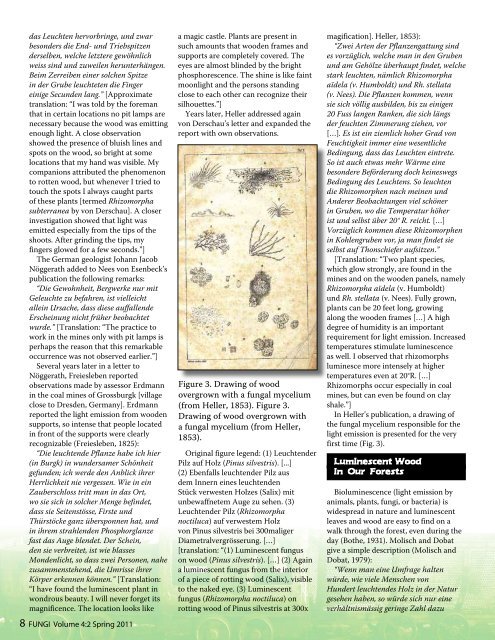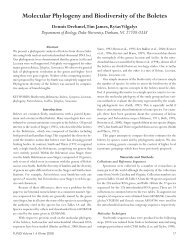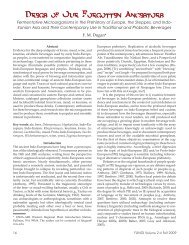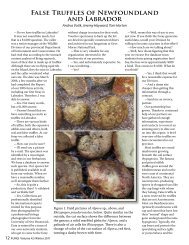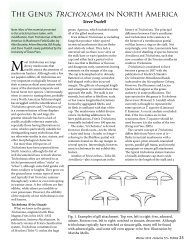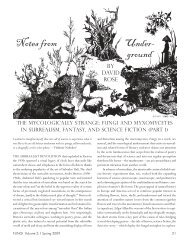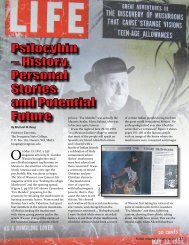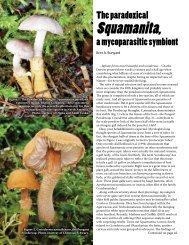by Helmut Brandl
by Helmut Brandl
by Helmut Brandl
You also want an ePaper? Increase the reach of your titles
YUMPU automatically turns print PDFs into web optimized ePapers that Google loves.
das Leuchten hervorbringe, und zwar<br />
besonders die End- und Triebspitzen<br />
derselben, welche letztere gewöhnlich<br />
weiss sind und zuweilen herunterhängen.<br />
Beim Zerreiben einer solchen Spitze<br />
in der Grube leuchteten die Finger<br />
einige Secunden lang.” [Approximate<br />
translation: “I was told <strong>by</strong> the foreman<br />
that in certain locations no pit lamps are<br />
necessary because the wood was emitting<br />
enough light. A close observation<br />
showed the presence of bluish lines and<br />
spots on the wood, so bright at some<br />
locations that my hand was visible. My<br />
companions attributed the phenomenon<br />
to rotten wood, but whenever I tried to<br />
touch the spots I always caught parts<br />
of these plants [termed Rhizomorpha<br />
subterranea <strong>by</strong> von Derschau]. A closer<br />
investigation showed that light was<br />
emitted especially from the tips of the<br />
shoots. After grinding the tips, my<br />
fingers glowed for a few seconds.”]<br />
The German geologist Johann Jacob<br />
Nöggerath added to Nees von Esenbeck’s<br />
publication the following remarks:<br />
“Die Gewohnheit, Bergwerke nur mit<br />
Geleuchte zu befahren, ist vielleicht<br />
allein Ursache, dass diese auffallende<br />
Erscheinung nicht früher beobachtet<br />
wurde.” [Translation: “The practice to<br />
work in the mines only with pit lamps is<br />
perhaps the reason that this remarkable<br />
occurrence was not observed earlier.”]<br />
Several years later in a letter to<br />
Nöggerath, Freiesleben reported<br />
observations made <strong>by</strong> assessor Erdmann<br />
in the coal mines of Grossburgk [village<br />
close to Dresden, Germany]. Erdmann<br />
reported the light emission from wooden<br />
supports, so intense that people located<br />
in front of the supports were clearly<br />
recognizable (Freiesleben, 1825):<br />
“Die leuchtende Pflanze habe ich hier<br />
(in Burgk) in wundersamer Schönheit<br />
gefunden; ich werde den Anblick ihrer<br />
Herrlichkeit nie vergessen. Wie in ein<br />
Zauberschloss tritt man in das Ort,<br />
wo sie sich in solcher Menge befindet,<br />
dass sie Seitenstösse, Firste und<br />
Thürstöcke ganz übersponnen hat, und<br />
in ihrem strahlenden Phosphorglanze<br />
fast das Auge blendet. Der Schein,<br />
den sie verbreitet, ist wie blasses<br />
Mondenlicht, so dass zwei Personen, nahe<br />
zusammenstehend, die Umrisse ihrer<br />
Körper erkennen können.” [Translation:<br />
“I have found the luminescent plant in<br />
wondrous beauty. I will never forget its<br />
magnificence. The location looks like<br />
8 FUNGI Volume 4:2 Spring 2011<br />
a magic castle. Plants are present in<br />
such amounts that wooden frames and<br />
supports are completely covered. The<br />
eyes are almost blinded <strong>by</strong> the bright<br />
phosphorescence. The shine is like faint<br />
moonlight and the persons standing<br />
close to each other can recognize their<br />
silhouettes.”]<br />
Years later, Heller addressed again<br />
von Derschau’s letter and expanded the<br />
report with own observations.<br />
Figure 3. Drawing of wood<br />
overgrown with a fungal mycelium<br />
(from Heller, 1853). Figure 3.<br />
Drawing of wood overgrown with<br />
a fungal mycelium (from Heller,<br />
1853).<br />
Original figure legend: (1) Leuchtender<br />
Pilz auf Holz (Pinus silvestris). [...]<br />
(2) Ebenfalls leuchtender Pilz aus<br />
dem Innern eines leuchtenden<br />
Stück verwesten Holzes (Salix) mit<br />
unbewaffnetem Auge zu sehen. (3)<br />
Leuchtender Pilz (Rhizomorpha<br />
noctiluca) auf verwestem Holz<br />
von Pinus silvestris bei 300maliger<br />
Diametralvergrösserung. […]<br />
[translation: “(1) Luminescent fungus<br />
on wood (Pinus silvestris). […] (2) Again<br />
a luminescent fungus from the interior<br />
of a piece of rotting wood (Salix), visible<br />
to the naked eye. (3) Luminescent<br />
fungus (Rhizomorpha noctiluca) on<br />
rotting wood of Pinus silvestris at 300x<br />
magification]. Heller, 1853):<br />
“Zwei Arten der Pflanzengattung sind<br />
es vorzüglich, welche man in den Gruben<br />
und am Gehölze überhaupt findet, welche<br />
stark leuchten, nämlich Rhizomorpha<br />
aïdela (v. Humboldt) und Rh. stellata<br />
(v. Nees). Die Pflanzen kommen, wenn<br />
sie sich völlig ausbilden, bis zu einigen<br />
20 Fuss langen Ranken, die sich längs<br />
der feuchten Zimmerung ziehen, vor<br />
[…]. Es ist ein ziemlich hoher Grad von<br />
Feuchtigkeit immer eine wesentliche<br />
Bedingung, dass das Leuchten eintrete.<br />
So ist auch etwas mehr Wärme eine<br />
besondere Beförderung doch keineswegs<br />
Bedingung des Leuchtens. So leuchten<br />
die Rhizomorphen nach meinen und<br />
Anderer Beobachtungen viel schöner<br />
in Gruben, wo die Temperatur höher<br />
ist und selbst über 20° R. reicht. […]<br />
Vorzüglich kommen diese Rhizomorphen<br />
in Kohlengruben vor, ja man findet sie<br />
selbst auf Thonschiefer aufsitzen.”<br />
[Translation: “Two plant species,<br />
which glow strongly, are found in the<br />
mines and on the wooden panels, namely<br />
Rhizomorpha aïdela (v. Humboldt)<br />
und Rh. stellata (v. Nees). Fully grown,<br />
plants can be 20 feet long, growing<br />
along the wooden frames […] A high<br />
degree of humidity is an important<br />
requirement for light emission. Increased<br />
temperatures stimulate luminescence<br />
as well. I observed that rhizomorphs<br />
luminesce more intensely at higher<br />
temperatures even at 20°R. […]<br />
Rhizomorphs occur especially in coal<br />
mines, but can even be found on clay<br />
shale.”]<br />
In Heller’s publication, a drawing of<br />
the fungal mycelium responsible for the<br />
light emission is presented for the very<br />
first time (Fig. 3).<br />
Bioluminescence (light emission <strong>by</strong><br />
animals, plants, fungi, or bacteria) is<br />
widespread in nature and luminescent<br />
leaves and wood are easy to find on a<br />
walk through the forest, even during the<br />
day (Bothe, 1931). Molisch and Dobat<br />
give a simple description (Molisch and<br />
Dobat, 1979):<br />
“Wenn man eine Umfrage halten<br />
würde, wie viele Menschen von<br />
Hundert leuchtendes Holz in der Natur<br />
gesehen haben, so würde sich nur eine<br />
verhältnismässig geringe Zahl dazu


